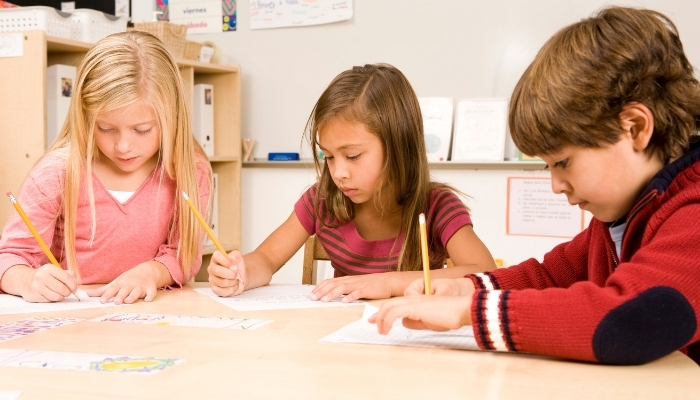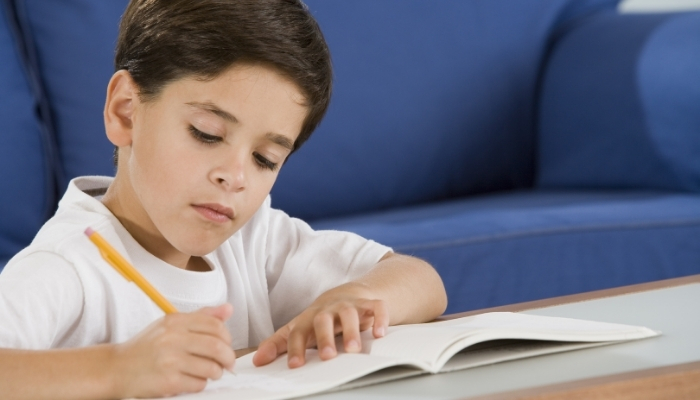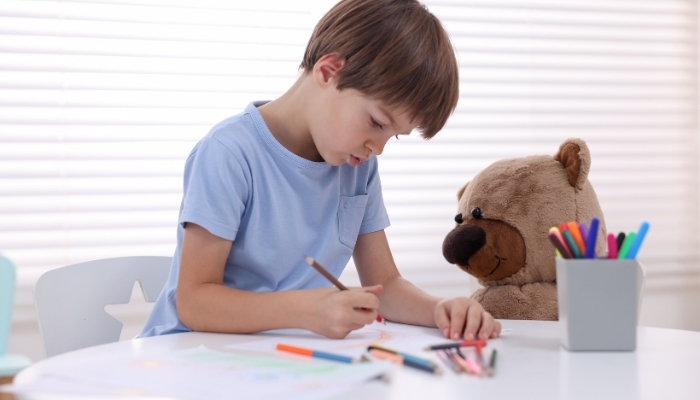Spring is a brilliant time for new growth, and that includes your child's learning. As the flowers bloom and the kids spend more time exploring the backyard, it can be tough to keep them focused on foundational learning skills, especially writing. If you’ve wondered how to gently encourage your kindergarten child to start putting ideas on paper, you're in the right place.
You don't need a formal curriculum to spark a love for storytelling. Early writing prompts make learning playful, whether it's scribbles, drawings, or dictating a tale to you. These simple activities boost fine motor skills and expand their vocabulary without any pressure.
In this blog, we’ll explore a few spring-themed writing prompts for kindergarten kids. We'll show you how to use these prompts to guide your child, turning a fun drawing session into a positive step toward reading and writing success.
Key Takeaways
-
Drawing is Writing: For kindergarten kids, pictures and scribbles count as writing. Focus on their story, not their spelling.
-
Dictation is Key: Motivate your child to tell you their story while you write it down. This powerfully links their spoken ideas to written words.
-
Spring Writing Prompts are easy to use and tap into seasonal themes (flowers, new life) to naturally expand your child's vocabulary.
-
Keep it Short & Fun: Writing sessions should be 5–10 minutes and always end before they get frustrated. Let them choose the prompt.
-
Next Level Support: The FunFox Writers Club provides the necessary structure and expert guidance to transition from playful prompts to strong primary school writing skills.
What Are Spring Writing Prompts?
When you look at spring writing prompts for your kindergarten child, forget about formal essays or needing perfect spelling. Instead, think of a prompt as a gentle, seasonal spark designed to kickstart their imagination and creative process.

A writing prompt is simply an idea that enables your child to express themselves, whether through a picture, a scribble, or a short verbal story. By connecting these ideas to the sights and sounds they're already excited about, like baby birds, vibrant flowers, and growing seeds, we naturally capture their curiosity and guide it toward learning.
What Does a Spring Writing Prompt Include for Kindergarteners?
For a child in the early stages of literacy, a "writing prompt" can be incredibly simple and non-intrusive:
-
A Picture: Showing a photo of a caterpillar and asking, "What does this creature want to eat today?"
-
A Sentence Starter: "I saw a big, wet puddle, and I..."
-
A Simple Question: "If you could wear butterfly wings for a day, where would you fly?"
-
A Focus Word: Using a word like 'bloom' and asking them to draw what that means to them.
Also Read: 30+ Writing Name Activities for Kindergarten
Why Are These Prompts Beneficial for Kindergarten Kids?
These fun seasonal activities do much more than just fill up time. They are quietly building the essential foundation for capable readers and writers later on.
Here’s why embracing spring prompts helps your child blossom:
-
Boosts Fine Motor Skills: Holding a pencil, crayon, or marker to draw and scribble strengthens the small muscles needed for proper letter formation in the years ahead.
-
Expands Vocabulary: They naturally learn new, specific words related to nature and growth (budding, drizzle, nest, chirp) and have a chance to use them in context.
-
Develops Storytelling Skills: Even a drawing of a flower must have a beginning, middle, and end. This practice lays the groundwork for organising a narrative.
-
Increases Confidence: Since there are no "wrong" answers with prompts, your child feels successful and happy about their creation, prompting them to try writing again and again.
Now, let’s get their creativity flowing with this curated list of 50 spring-inspired writing prompts for kindergarten kids.
50 Spring Writing Ideas for Kindergarten Fun
This collection of prompts is designed to be flexible. Your child's response might be a drawing, a few dictated words, or even just some happy scribbles, and it all counts. Use these ideas to explore the world as it changes during the spring season.

10 New Life and Garden Prompts
The garden becomes a magical place in spring, full of tiny creatures and busy plants. This category uses real-life observations to inspire creative storytelling, helping your child connect what they see outside with what they can create on the page.
-
If you were a busy bee, where would you fly first to find the best flower?
-
Draw a family of baby birds hatching in a nest. What do they sound like?
-
What does a tiny seed need to grow big and strong? Draw the process.
-
Imagine you found a friendly caterpillar in your backyard. What name would you give it, and what is its favorite snack?
-
If you could give a flower a superpower, what would it be?
-
Draw a picture of your favorite springtime animal and tell me three things it does all day.
-
If you could talk to a ladybug, what would you ask it?
-
Draw the biggest, brightest rainbow you’ve ever seen. What is waiting at the end of it?
-
What color is happiness? Draw something spring-related in that color.
-
A little gnome appears under a mushroom. What mission does he give you?
10 Weather and Sensory Play Prompts
Spring weather is unpredictable, with sunny days, light rain, and gentle breezes offering a perfect range of sensory experiences. These prompts help your child to use their five senses, which is a powerful way to build descriptive language and early comprehension skills.
-
You spot a big, wet puddle outside. What would you do in it, or what would you sail across it?
-
Draw a picture of what a windy day sounds and feels like.
-
What is your favorite thing to wear or do when the weather first gets warm?
-
Imagine the sun is wearing a hat today. What does the hat look like?
-
If the clouds could talk, what story would they tell about the rain?
-
Draw a picnic blanket on a sunny day. What three yummy things are you eating?
-
Tell me about the silliest thing you've seen the wind blow away.
-
What does the air smell like after a light spring rain?
-
If you were a raindrop, where would you land, and what would you see?
-
Draw a picture of a giant bubble floating through the air. Who pops it?
10 Creative Story Starters and Finish the Sentence Prompts
Sometimes, the best way to get writing is with a clear starting point. These prompts provide the opening line, removing the initial hurdle of a blank page and allowing your child to focus solely on their unique continuation of the story.
-
One morning, I woke up and saw a massive flower outside my window...
-
I found a brightly colored egg under the porch, and when it cracked open...
-
The little pink butterfly landed right on my nose and whispered a secret about...
-
If my teddy bear could jump in puddles, he would wear these boots...
-
The sun told me that today was the perfect day to...
-
I looked outside and saw that all the grass had turned my favorite color. It was...
-
My spring wish is...
-
We are going on a hunt for hidden treasures in the garden, and we need...
-
I made friends with a ladybug named...
-
When I go to the park, I like to look for...
Also Read: Kindergarten Story Writing Steps, Tips, and Techniques for Kids
10 Action and Movement Prompts
Spring is a season of energy. These prompts are all about movement, action, and imaginative play, encouraging your child to use stronger verbs and put their characters into motion. This helps develop crucial sequence and narrative structure.
-
Draw and write about how high you can jump. Can you jump as high as a bird?
-
What kind of silly dance would you do to make the flowers grow faster?
-
Pretend you are flying a kite. What are you holding, and how fast are you running?
-
Draw a picture of your favorite outside activity and explain why it makes you run and jump.
-
If you were a baby animal, how would you learn to walk or run?
-
Show me all the things you can find to play with in your garden right now.
-
Draw a self-portrait of yourself doing a big spring clean (or spring dance).
-
Write or draw about a time you helped plant something with your family.
-
Imagine you are bouncing on a trampoline made of clouds. What happens when you bounce?
-
What is the silliest game you and your friends play outside when the sun is shining?
10 Australian-Specific Spring Prompts
While spring feels similar everywhere, it’s wonderful to celebrate what makes the Australian spring unique! These prompts reference local observations and activities, grounding the creative process in their familiar community and environment.
-
Draw a picture of a Magpie or Kookaburra that you see in spring. What are they saying?
-
In Australia, spring means going to the beach soon! What three things do you need for a day near the water?
-
It's almost time for daylight saving (in most states). What will you do with the extra hour of sunshine?
-
Draw your family preparing for a classic spring BBQ.
-
Imagine you are a Koala waking up from a nap. What is the first thing you want to eat?
-
Spring in Australia is also called the 'Season of New Life.' Draw all the new things you see around you.
-
What flowers or plants are blooming in your local park or street right now?
-
Draw your best picture of a 'Slip Slop Slap' Spring day!
-
If you could visit any zoo in Australia this spring, which animal would you rush to see?
-
Tell me about a time you saw a rainbow over your house.
Having this list of ideas is a great start, but the real secret to success is knowing how to support your child as they use them. Let's look at some actionable tips for making every prompt a positive experience.
Practical Tips for Supporting Early Writers
Getting your kindergarten child excited about writing is easy, but it's natural to worry about messy letters or pencil grip. Remember, at this stage, the main goal is to prevent early frustration and preserve their enthusiasm.

Here are some simple, powerful strategies that will help you turn every scribble into a positive step toward literacy:
1. Make Drawing Count as Writing
The biggest hurdle for parents is often that their child "can't write yet." For early learners, the picture is the story.
-
Provide large paper and plenty of colorful tools (crayons, markers).
-
When they finish their drawing, ask them to tell you the story behind the picture verbally.
-
Write their words down underneath their artwork exactly as they say them (this is called dictation).
The Benefit: This practice validates their ideas, helping them connect spoken language with written words, which is key to early reading success.
2. Focus on the Story, Not the Spelling
When your child attempts to write letters or words, correcting them too quickly can stop the flow of ideas and creative thinking.
-
When responding, praise the imagination first: "Wow, I love the story about the flower wearing a tiny hat!"
-
If they ask how to spell a word, try "invented spelling," focusing on writing the sounds they hear (e.g., kik for kick).
-
Model the correct spelling gently later, but let the creative idea come first.
The Benefit: By prioritizing the narrative, you teach them that their voice matters, fostering the foundational desire to communicate, rather than focusing on the mechanics.
Also Read: Fun Ways to Teach Writing Letters That Make Learning Enjoyable
3. Set Up a Simple ‘Creation Station’
You don't need a dedicated study room. A defined, inviting space signals that it's time for creativity and signals that their work is important.
-
Designate a small bin or basket as the "Writing Kit."
-
Keep it stocked with paper, their favorite pencils or crayons, and maybe some fun spring-themed stickers.
-
Bring the kit out a few times a week for a relaxed 10–15-minute session.
The Benefit: A consistent routine builds a strong learning habit. It gives them ownership over the process and removes the friction of gathering supplies.
4. Read their Stories Out Loud (with Feeling)
Hearing their words read back validates their effort and helps them connect the sounds they made to the text on the page.
-
When reading their dictated or written story back to them, use an animated voice.
-
Point to the words (if they’ve written them) as you read to show the connection between the spoken word and the text.
-
Ask simple follow-up questions: "What happens next?"
The Benefit: This is an organic way to boost their early reading comprehension and vocabulary, showing them the tangible result of their "writing" efforts.
5. Keep it Short, and Let them Choose
For a kindergarten kid, a focused 5–10-minute session is much better than a forced, frustrating 30-minute one.
-
Let your child choose the prompt from the list, or allow them to reject a prompt that doesn't appeal.
-
Set a simple time limit ("Let's write until the little hand reaches the two").
-
If they lose interest or get frustrated, stop immediately.
The Benefit: Offering choice gives them ownership, reducing resistance and helping writing stay associated with fun and independence, not academic stress.
6. Display their Work Proudly
The simplest way to reinforce their belief in themselves is by celebrating their finished product, no matter how messy the letters are.
-
Create a special spot, a "Creative Corner" or "Author's Wall," on the fridge or a bedroom wall.
-
Display their drawings and stories prominently.
-
Send a quick photo of their creation to a grandparent or family member.
The Benefit: Seeing their work valued motivates them to create more. It builds their identity as an author and a capable communicator, reinforcing their desire to keep practicing.
These home-based activities are wonderful for sparking joy in writing. But as your child grows and their skills advance, the journey often benefits from dedicated, expert guidance to establish their abilities.
Also Read: Top 100 Persuasive Writing Topics for Kindergarten That Encourage Thinking
Building Strong, Capable Writers with the FunFox Writers Club
As your child moves past the early years and steps into the primary school grades (Years 2-6), the learning shifts. It becomes a time to master the rules of language, like punctuation and proper structure. That jump can feel big.

The FunFox Writers Club is specifically designed to bridge that gap, taking your child’s enthusiasm and providing the expert, fun structure they need to become confident writers.
Why the FunFox Writers Club is the Perfect Fit:
-
Small Group, Big Focus: Classes are capped at a maximum of six students to give your child personalized attention and direct, timely feedback.
-
Experienced Educators: Your child learns from dedicated, skilled educators who are all trained in the successful FunFox Way, where every online class offers a fun, interactive, and positive learning environment.
-
Master the Foundations: We build a rock-solid base. Your child will master the core technical elements of writing, including punctuation, spelling, and grammar.
-
Interactive Learning Portal: Gain access to our digital learning portal, which is packed with proprietary interactive worksheets and games to make essential practice fun and rewarding.
-
Aligned with Australian Schooling: Our program is expertly matched to the Australian curriculum, so what they learn with us supports their learning and progress in the classroom.
-
Catch Up or Replay: If you can't make a live Zoom session, session recordings are available so your child never misses out on key content or skill development.
At FunFox, we directly address the challenges your child faces by providing structured support that grows with them, turning scribbles into structured sentences. Our expert teachers know how to motivate young authors while focusing on the essential building blocks like grammar, spelling, and creative expression.
Conclusion
The return of spring is the perfect time to turn your child's natural excitement into their first successful writing adventures. These fun kindergarten writing prompts are the simple tool you need to bring their ideas to life on the page. You've successfully given them the power of expression and a love for creating.
There's nothing better than watching your child light up when they realize their stories are worth sharing. As that passion for communication takes hold and they prepare for primary school, the FunFox Writers Club offers the expert, supportive structure they deserve through the FunFox Way.
Book your free trial class today to give your budding author the guidance they need to transition from playful prompts to structured primary school writing.
FAQs
1. My child only wants to draw pictures. Should I make them write letters too?
No, their drawing is their story. Encourage them to tell you about the picture, and you can write their words down (dictation). This builds their confidence and links spoken words to text without pressure.
2. How long should a writing session last for a kindergartener?
Keep it short and fun, ideally no more than 5 to 10 minutes of focused activity. The goal is consistency and enjoyment, not duration, which helps prevent frustration.
3. What specific supplies should I buy for a spring writing station?
Stock colorful crayons, thick pencils, large paper, and maybe some scissors for cutting out drawings. Novelty items like scented markers can also boost engagement.
4. When should I introduce proper punctuation like full stops and capitals?
You can model it naturally while doing dictation, but don't expect them to master it yet. Focus on them simply expressing a complete thought first, then show them where the "stopping spot" (full stop) goes.
5. How are these spring prompts different from general writing prompts?
Spring prompts use themes the child can actively see and touch (flowers, puddles, bees), which makes the ideas more concrete and relatable, immediately sparking their imagination and sensory language.















